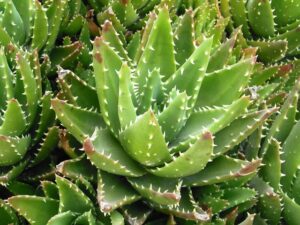Top 5 Stunning Flowering Succulents for your Landscape!
Growing outdoor flowering succulents can be a rewarding and low-maintenance way to add beauty and interest to your garden or outdoor space. Succulents are known for their ability to store water in their fleshy leaves and stems, making them well-suited for arid or dry environments.

Planting succulents as part of your landscapes offers a range of benefits that make these unique plants a popular choice for both novice and experienced gardeners. Here are some of the key advantages of gardening with succulents:
- Drought Tolerance: Succulents are highly drought-tolerant plants. They can survive extended periods of dry conditions, making them well-suited for arid and water-scarce regions. This reduces the need for constant watering providing some cost savings on your water bill.
- Variety of Shapes and Colors: These plants come in a wide range of shapes, sizes, and colorsThis diversity allows you to create visually appealing and exotic garden designs, whether you prefer vibrant hues, dramatic textures, or intricate patterns.
- Indoor and Outdoor Versatility: Succulents can be grown both indoors and outdoors, providing flexibility in how and where you choose to incorporate them into your garden or home decor.
- Erosion Control: Some succulents, like sedums and groundcover varieties, are excellent for erosion control on slopes or in areas where soil stabilization is needed.
These succulents are best grown in zones 6-11 with mild frost-free winters and moderate termperatures. Choose a location in your garden that receives plenty of direct sunlight, ideally at least 6 hours per day. It can tolerate some light shade, but full sun is preferable for optimal flowering.
Here are our top 5 flowering succulents for outdoor gardens, each known for its unique beauty and resilience.

Aeonium arboreum
Also known as Irish Rose is a striking succulent that grows in a rosette pattern, forming a dense, rounded cluster of leaves. The leaves are fleshy, spoon-shaped, and have a glossy texture. They are usually green, but some varieties can have reddish or purplish tips. This plant is native to the Canary Islands, where it typically grows in rocky, volcanic soils.
The Irish Rose can be propagated from stem cuttings. The cuttings should be allowed to callus for a day or two before planting in well-draining soil.

Echeveria gibbiflora – Lipstick Echeveria
The Lipstick Echeveria is known for its rosette-shaped arrangement of leaves, which are typically broad and fleshy. The leaves are often bluish-green in color and can have a waxy or powdery coating, giving them a unique texture. This plant produces rosettes that can grow up to several inches in diameter and reach a height of around 12 inches. Echeverias are often propagated through offsets or “pups” that develop at the base of the main rosette. These can be separated and planted to grow new plants.

Delosperma cooperi – Cooper’s Ice Plant
Commonly known as Trailing Ice Plant or Hardy Ice Plant, is a low-growing, succulent perennial that belongs to the family Aizoaceae. Native to South Africa, this plant is widely cultivated for its vibrant, daisy-like flowers and trailing or spreading growth habit. As a ground cover, Delosperma cooperi exhibits a trailing or spreading growth habit. It forms dense mats that can cascade over walls or the edges of containers, making it a popular choice for rock gardens, borders, and hanging baskets.

Aloe brevifolia – Short Leaf Aloe:
The Short-leaved Aloe or Kraalaalwyn, is a species of succulent plant that belongs to the Aloe genus within the Asphodelaceae family. Native to South Africa, specifically in the Western Cape region, this aloe species is appreciated for its distinctive appearance and suitability for cultivation in arid and semi-arid environments.
When in bloom, Aloe brevifolia produces tubular, orange to red flowers on tall, slender stems. The flowering period typically occurs in late winter to early spring, adding an additional ornamental element to the plant. Like many aloes, Aloe brevifolia can be propagated through offsets or seeds. Offsets, often called “pups,” can be carefully separated from the parent plant and replanted to establish new individuals.

Aptenia cordifolia – Baby Sun Rose:
The Heartleaf Ice Plant or Baby Sun Rose, is a low-growing, trailing succulent plant belonging to the Aizoaceae family. One of the standout features of Aptenia cordifolia is its bright, daisy-like flowers. The flowers can be various shades of pink, magenta, or purple, and they have a distinctive, central eye. The bloom period typically occurs in late spring to summer, but under favorable conditions, the plant may produce flowers intermittently throughout the year.
Propagation of Aptenia cordifolia is typically done through stem cuttings. These cuttings can be rooted in well-draining soil, and once established, they will develop into new plants.
When selecting succulents for your outdoor garden, consider your local climate and the specific growing conditions of your garden. Different succulent varieties have different needs, so it’s essential to choose those that are well-suited to your region. Proper placement, well-draining soil, and appropriate watering will help your flowering succulents thrive and provide a stunning display in your garden. For more information visit The Ultimate Guide to Planting Succulents!